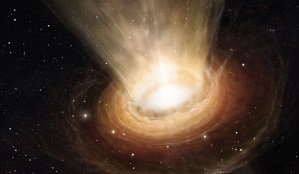
Brazilians explain dust from the Black Hole
When we photograph infrared telescopes, instead of finding a torus  (a kind of form the circular donut), the researchers SF Hönig, M. Kishimoto, MA Prieto, P. Gandhi, D. Asmus, R. Antonucci, L. Burtscher, WJ Duschl and G. Weigelt, found a dust that was pushed away from the black hole in the form of a wind, indicating a new and unknown phenomenon by physics, the publication was made in the Astrophysical Journal in 2013.
(a kind of form the circular donut), the researchers SF Hönig, M. Kishimoto, MA Prieto, P. Gandhi, D. Asmus, R. Antonucci, L. Burtscher, WJ Duschl and G. Weigelt, found a dust that was pushed away from the black hole in the form of a wind, indicating a new and unknown phenomenon by physics, the publication was made in the Astrophysical Journal in 2013.
The Brazilian astrophysics Thaisa Storchi Bergmann of UFRGS, many cited in numerous articles, which had already found the supermassive black hole in the galaxy NGC 1097 source of countless subsequent works, already warned that the Black Hole Theory could have misunderstandings, since there was evidence of the presence of a flat, ring-shaped cloud composed of plasma (protons and electrons) and hydrogen spinning at 10,000 km per second (km / s).
The Brazilian received numerous awards and honors for her work.
Brazilian astronomers João Steiner and Daniel May, both of the USP’s Institute of Astronomy, Geophysics and Atmospheric Sciences (IAG), concluded by contradicting the common sense that black holes expel much of the gas that lies at the center of galaxies rather than engulf it, and more accurately locate how it is made, its published in magazine Monthly Notices of the Royal Astronomical Society.
Astronomers have shown that the Wind is formed in two stages. In the first stage, the strong electromagnetic radiation coming from the disk in the vicinity of the black hole (primary wind) impacting the dust torus located three light years from the black hole, which evaporates the torus expelling the gas contained in it.
The second stage is more violent, occurs when the primary wind and a powerful particle jet, collimated by a strong central magnetic field, reaches a large cloud of molecular gas (composed mainly of molecules of two hydrogen atoms) located at 100 years- light away from the black hole, still in the center of the galaxy (which has a diameter of 100,000 light-years).
Gradually the black hole, unknown by science, becomes more “clear”.









